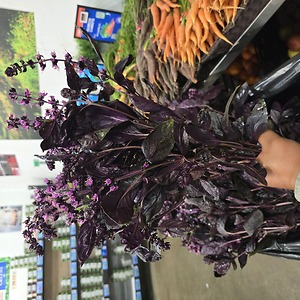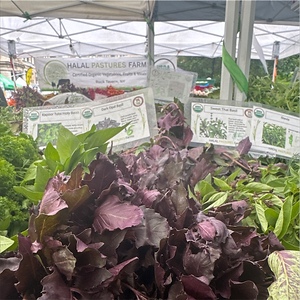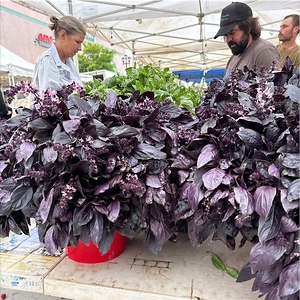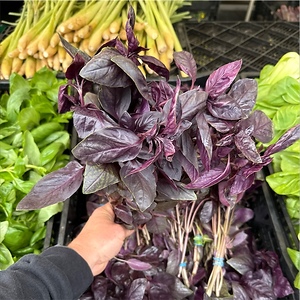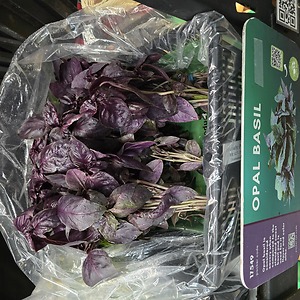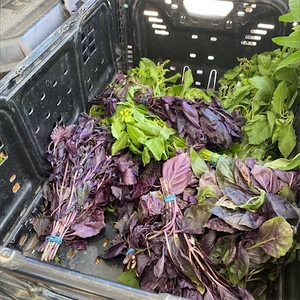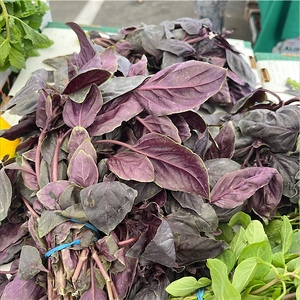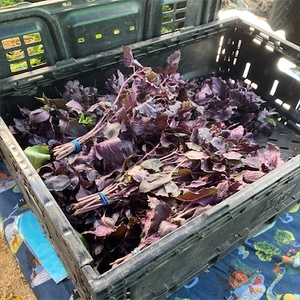


Opal Basil
Estimated Inventory, lb : 35.64
This item was last sold on : 07/29/25
Description/Taste
Dark Opal basil plants have a uniform appearance with small to medium-sized leaves, averaging 3 to 7 centimeters in length, with an oval shape tapering to a distinct point on the non-stem end. The leaves are smooth with defined veining and serrated edges, creating a crinkled texture, and appear in variegated hues of dark purple, burgundy, and green. It is important to note that the basil's color may intensify with maturity, but mottled green leaves are considered normal and common among the variety. The leaves also bear a faint, iridescent sheen when in sunlight. Attached to the leaves, there is a four-sided, dark red to purple stem that is semi-thick, crunchy, and fibrous. Dark Opal basil is aromatic, bearing a spice-forward, clove-like scent, and the leaves have a sweet, savory, and earthy flavor with notes of anise, ginger, cinnamon, clove, and mint. In the summer, the plants produce upright stalks with small lilac-pink flowers. Dark Opal basil flowers are edible and have a mild, subtly sweet, and vegetal flavor.
Seasons/Availability
Dark Opal basil is available year-round in warm climates, and the plant will flower in the mid to late summer.
Current Facts
Dark Opal basil, botanically classified as Ocimum basilicum, is a fragrant, pigmented basil variety belonging to the Lamiaceae or mint family. The burgundy to purple basil is an annual, bushy plant, reaching up to sixty centimeters in height, and is favored as a specialty home garden variety, used for culinary and ornamental purposes. Dark Opal basil was one of the first dark-colored basil varieties to be created within the United States. With the variety’s success in American gardens, being one of the most recognizable purple varieties in the modern-day, many different purple varieties were created using Dark Opal basil as a parent variety, developing a new market sector for home gardening. Dark Opal basil can be grown in containers and is highly aromatic, repelling some insects in gardens. It is also a cut-and-come-again variety, utilized in culinary applications as a flavoring and edible, attractive garnish. Dark Opal basil's deep purple color can also be used as a food-grade dye for both edible and non-edible products.
Nutritional Value
Dark Opal basil is a good source of vitamin K to assist in faster wound healing, vitamin C to strengthen the immune system, and beta-carotene, a compound converted into vitamin A in the body to maintain optimal organ functioning. The purple-hued basil also contains lower amounts of magnesium, potassium, calcium, iron, and anthocyanins, which are flavonoids that provide antioxidant-like properties. Beyond vitamins and minerals, Dark Opal basil leaves are used topically in natural medicines to reduce inflammation associated with bug bites, rashes, and skin irritation.
Applications
Dark Opal basil leaves have a fragrant aroma and mild taste best suited for flavoring both fresh and cooked preparations. The purple leaves can be lightly torn or crushed and tossed into green salads, used whole as an edible garnish on fruit and cheese platters, or roughly chopped and mixed into pasta and stir-fries. Dark Opal basil leaves can also be layered into sandwiches, stirred into curries, soups, and stews, dried as a seasoning, blended into sauces such as pesto, or served with seafood to create depth of flavor. Beyond fresh applications, Dark Opal basil leaves can be steeped into a tea, or they will impart a faint red-purple hue when soaked, popularly infused to add pigment, aroma, and a light anise-like taste in culinary oils and vinegar. Dark Opal basil can also replace green basil varieties in caprese salads, and most other recipes calling for standard sweet basil. In addition to the leaves, the lilac-pink flowers are used as a decorative, edible garnish for soups, drinks, main dishes, and desserts. Dark Opal basil pairs well with tomatoes, potatoes, corn, zucchini, ginger, fruits such as strawberries, watermelon, and blackberries, nuts such as pine nuts, almonds, and walnuts, cheeses such as parmesan, goat, mozzarella, and feta, rice, pasta, and legumes. Sprigs of Dark Opal basil can be stored in a glass of water and covered with a plastic bag, where it will keep 3 to 7 days when stored in the refrigerator. The leaves can also be stored in their original container if purchased in a clamshell for a couple of days or wrapped in paper towels and stored in a plastic bag in the refrigerator.
Ethnic/Cultural Info
Dark Opal basil received nationwide recognition among American gardeners when it was released in 1962. The variety was sold through the Ferry-Morse Seed Company and had its own, one-page spread in the company’s catalog. The advertisement introduced the variety as a new cultivar and featured photos with short descriptors endorsing the variety's unique traits, highlighting the basil’s flavor, color, and fragrance. Dark Opal basil was also pushed as both an ornamental and culinary cultivar, promoting the variety’s versatility. That same year, Dark Opal basil was chosen as an All-America Selections winner, selected for its quality growth characteristics for cultivation in North America, further establishing the variety as a home garden favorite.
Geography/History
Dark Opal basil was developed at the University of Connecticut in the 1950s. Wild basil seeds were collected from Turkey through the United States Department of Agriculture and were sent to the University of Connecticut for research and breeding. Scientists John Scarchuk and Joseph Lent planted the seeds and selected a dark-purple basil plant from the seedlings for further cultivation. Scarchuk and Lent performed several years of breeding to develop a purple basil variety with a uniform appearance and flavor, eventually creating Dark Opal basil. The new variety was released in 1962 through the Ferry-Morse Seed Company, and over time, the purple cultivar became a common home garden plant. Dark Opal basil is sold fresh through specialty grocers and farmer’s markets, and it is also offered in seed form through retailers and online seed companies.
Featured Restaurants
Restaurants currently purchasing this product as an ingredient for their menu.
| Campfire Bar | Carlsbad CA | 858-231-0862 |
| Wine Vault & Bistro | San Diego CA | 619-295-3939 |
| Counterpoint | San Diego CA | 619-564-6722 |
| Yoann Taboyan, Personal Chef | San Diego CA | 347-277-1958 |
| Javier Plascencia (Animalon) | Bonita CA | 619-295-3172 |
| Campfire | Carlsbad CA | 760-637-5121 |
| Mothership | San Diego CA | 858-342-3609 |
| Animae | San Diego CA | 619-925-7908 |
| Little Victory Wine Market | Carlsbad CA | 310-738-3380 |
| Lola 55 | San Diego CA | 619-727-9282 |
| C 2 C | San Diego CA | 619-972-9345 |
| Bar Same Same (Kitchen) | Carlsbad CA | 760-470-9143 |
| Viewpoint Brewing Co. | Del Mar CA | 858-205-9835 |
| Trust Restaurant | San Diego CA | 609-780-7572 |
| Artifact at Mingei | San Diego CA | 619-846-2164 |
| Georges at the Cove | San Diego CA | 858-454-4244 |
| The Victorian at Hill Street | Oceanside CA | 442-266-8285 |
| Sago | Encinitas CA | 858-382-4047 |
| Bica | San Diego CA | 619-669-5725 |
| Herb & Wood | San Diego CA | 520-205-1288 |
| Dija Mara | Oceanside CA | 760-231-5376 |
| Pali Wine Company | San Diego CA | 310-893-0038 |
| Craft and Commerce (Sekscobra Inc.) | San Diego CA | 619-962-5935 |
| Espadin | Temecula California | 951-383-5585 |
| Cellar Hand | San Diego CA | 334-689-2388 |
Recipe Ideas
Recipes that include Opal Basil. One



